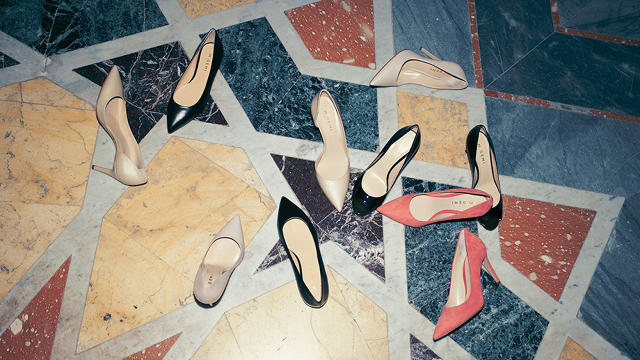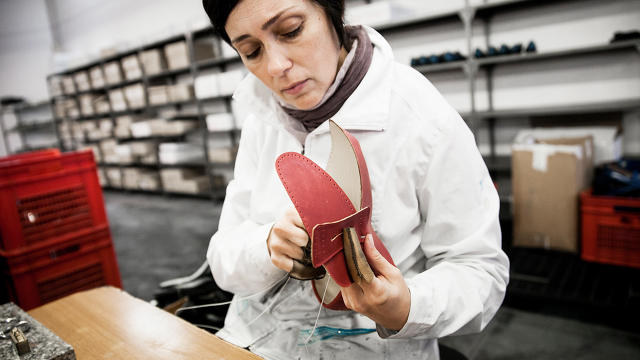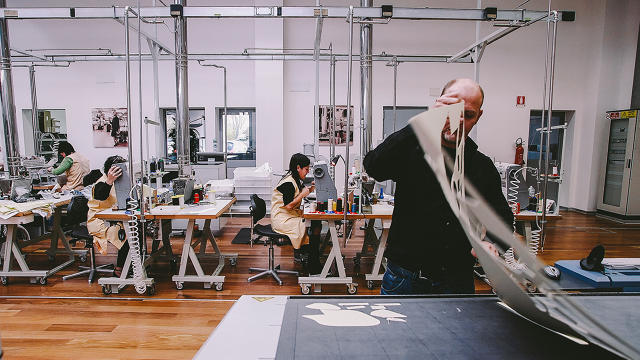These Fashion Startups Offer The Prestige Of “Made In Italy” Without Inflated Prices
Amanda Carye stumbled on the idea for her shoe company, Idoni, when she moved to Italy for a six-month business course.
Strolling past gelato stands and chapels in Venice, she came across shops selling furlane, a slipper invented during the Second World War, when resources were scarce. At the time, Italian shoemakers—whose craft is still passed down from generation to generation—took pride in being able to make a beautiful shoe out of pretty much anything. They used old bicycle tires to create soles with good grips, jute bags for a waterproof interior, and lush recycled fabrics like velvet curtains or silk dresses for the upper. The result was a shoe that looked like a cross between a ballet flat and a smoking slipper, with a colorful exterior and excellent traction. “Old ladies remember wearing furlane when they were children, running around in the countryside,” Carye says. “The shoes are highly functional, but they are also very elegant.”
Carye’s plan was to modernize the furlane for American women, many of whom struggle to find footwear that is comfortable but doesn’t look like sneakers or (horrors) orthopedic shoes. While in Italy, she began to search for a factory where a master shoemaker could help her engineer a flat shoe that offered good arch support, stability, and cushioned insoles without sacrificing beautiful design. As Carye began the search, she found dozens of family-owned factories that had been making shoes for some of the world’s best known luxury brands, including Prada, Jimmy Choo, Christian Louboutin, and Manolo Blahnik. She landed on a factory in the Brescia region, two hours east of Venice, where the owner was just as excited about prototyping her ideal shoe as she was. Her brand, Idoni, was born.
Carye’s shoes go for $135, rather than the usual $600 you’d expect to pay for an exclusive “made in Italy” shoe. She’s able to set a reasonable price because she only sells the shoes on her website, following the model pioneered by Warby Parker and Everlane that cuts out retailer markups. “Americans spearheaded the buying online and direct-to-consumer business models as a part of our everyday life, which allows American companies to go back to Italy or Spain or wherever the expertise is,” Carye says. “Everyone wants products that are handmade by the most skilled artisans in the world. In turn, this model allows European artisans to find a broader audience.”
J.Crew was among the first brands to mass-market Italian-made products—namely, shirts and shoes. Back in 2011, the company released a three-part documentary short series that took the viewer on a trip to old Italian mills and factories. Alessandro Giammattei, a Florence-based shoemaker profiled in the series, had spent 50 years honing his craft. “You breathe shoes around here,” he says on screen. “It’s in the blood. We make shoes that have nothing less in quality than Prada and Gucci.” And still, J.Crew was able to sell these shoes for about $150.
These days, J.Crew is competing with a wave of American fashion startups that manufacture in Italy—Idoni, M.Gemi, Cuyana, Tamara Mellon, Oliver Cabell, Greats, and Everlane to name a few—and offer their products at a fraction of the price of traditional luxury brands. All of these companies are selling shoes and bags at what is described as an “affordable luxury” price point of between $150 and $300 per item, which makes them accessible to a broader spectrum of buyers beyond than the usual one-percenters.

The Changing Landscape Of Italian Factories
Luca Bagante has had a front-row seat to this wave of American companies making a foray into Italian shoe factories. He’s a third-generation shoemaker in Padua whose grandfather opened a factory in the post-war years that produced footwear for famous brands like Rossimoda. These days, he still uses this factory to produce his own shoe line, Apepazza, but he’s also started a consulting firm that connects footwear startups from around the world with the right factory for their needs. “Italian shoe manufacturing is hard to navigate if you’re not Italian,” Bagante says. “Our network is made up of a lot of independent stores and factories.”
Italy is the second largest footwear exporter in the world, after China. Italian shoes generated $7.7 billion in revenue in 2016, but Bagante says that after the 2008 global recession, factories lost about 30% of their business. He’s noticed, however, that interest from American and European direct-to-consumer brands has contributed to Italian factories’ recovery.
According to the most recent data, released in 2014, there are more than 5,000 footwear manufacturers in Italy, employing about 77,500 workers. This means that the average factory only employs 15 people. Shoemaking skills are often passed down from parent to child; some businesses can trace their origins back to the medieval period, when a shoemaking guild was established in Florence and transformed the trade into an art governed by rigorous rules to ensure quality. “When Asia came into the global shoe market, it was impossible to compete with their cost of labor,” Bagante says. “In Italy, it was very important for us to emphasize our legacy of quality. Luxury was the only option for us to express our capabilities.”
Karla Gallardo, founder and CEO of Cuyana, which makes bags in Italy, points out that superior Italian workmanship has a lot to do with the fact that craftsmen are knowledgeable about the materials they work with because their factories are often located close to leather tanneries, allowing workers from both industries to collaborate to make the best possible product. “Leatherworkers in Italy are familiar with different grades of leather and know which parts of the hide works best for different products,” she says. “We’ve found that the quality of the workmanship goes down when leathers are flown in. It often means that [the factories] are importing cheaper, poorer-quality materials, and the craftsmen don’t have an intimate understanding of that particular material.”
-
An Italian factory where M.Gemi’s shoes are made.
-
Leather is sourced from nearby tanneries.
-
Shoemakers work with leatherworkers to find the right material.
-
All footwear is made by expert craftsmen.
-
Many learned the craft from their parents and grandparents.
-
All work is done by hand.
-
Each factory specializes in a particular type of footwear.
-
Some make sneakers, while others make heels or driving moccasins.
-
Some of the equipment has been updated.
-
But most of it remains unchanged from decades past.
Shoe factories are spread all over Italy. Marche, in the center of the country, makes the greatest volume of shoes; Veneto is known for its high-end luxury women’s shoes, hosting the factories that make produce goods for Louis Vuitton and Yves Saint Laurent; Apulia has factories that specialize in sneakers. There are also hubs in Tuscany, Lombardy, and Naples. But not all factories are created equal. The city of Prato just outside Florence has become a hot spot for low-end garment and shoe manufacturing. While inferior in quality, what’s produced here can still tout the “Made in Italy” stamp. The vast majority of the factories in the area are run by Chinese immigrants who have ties to Asian factories and tend to be focused on driving down the price as much as possible. The products often end up in fast-fashion retailers like Primark, Topshop, and H&M.
Artisans willing to take a chance on foreign startups that buck established industry traditions have been rewarded with a spike in business, allowing many of them to return to pre-recession capacity. “There are those who are smart enough to know that they have to react, change their business model and production,” Bagante says. “They are open to new ways of distributing their product.”
But it can be difficult convincing cobblers that a new business model can work. Carye, for instance, had to explain her online-only approach several times to the factory owner with whom she wanted to work. “He had heard of Bloomingdale’s and Nordstrom,” she says. “He had even heard of selling products on Amazon or Yoox. But the idea of selling a product on your own website sounded insane to him. He wasn’t sure anybody would buy the shoes.” Eventually, he took a chance on her.

A Post-Luxury World
One of the keys to these companies’ direct-to-consumer models is the idea of “post-luxury”: the craftsmanship and meticulous design of luxury without the artificially inflated prices and exclusivity. Maria Gangemi’s been familiar with this concept her whole life.
Growing up in Sicily, Gangemi remembers visiting boutiques that sold beautiful, high-quality shoes and bags made in local factories without massive markups. Over the years, however, she observed that Gucci, Prada, and other luxury brands were bringing more and more business to these factories in an effort to expand their output and global footprint. In the process, they edged out smaller brands that charged less for their products. Soon, the well-crafted heels and handbags that Gangemi loved stopped appearing in local shops.
She decided to take the model she had observed as a child and modernize it by selling her products online. This way, she could sell her shoes for between $150 and $300, about a third the price of Jimmy Choos or Manolo Blahniks. To do this, she had to build relationships with factories. As a native Italian, Gangemi has had an easier time navigating the manufacturing landscape than her American counterparts, but finding the right partners was still challenging. She spent months traveling around the country, talking to cobblers about the kind of shoes she wanted to make. Some factories exclusively make leather pumps; others specialized in driving moccs. As she expanded from heels and flats into boots, sneakers, and men’s shoes, she had to find other craftsmen with a variety of different skills.
These days, her New York-based company, M.Gemi, works with a dozen family-owned factories concentrated in the Florence region. She convinced these manufacturers to work with her by promising to order shoes throughout the year, rather than following the traditional two-season fashion calendar (which is itself becoming a relic of a bygone era). Gangemi wants to treat these factories like partners, collaborating with them on everything from shoe design to annual workflow. She hopes that by building long-term relationships with them, rather than just treating them like contractors, M.Gemi will be able to release a regular stream of fashion-forward shoes that are of the highest quality. “Commercializing shoes is very complex, particularly when it comes to fit,” Gangemi says. “We have very high standards because we’re an online brand, so the sizes need to be extremely consistent, which is a lot of work. But our factories are willing to work with us because they see that the partnership is very mutually beneficial.” Some of the factories now work exclusively with M.Gemi.
So far, M.Gemi’s approach has been working. Every Monday, the company “drops” new limited-edition shoes on the website—a clever way to give customers a reason to keep coming back. The shoes often sell out that week. Business has grown four times over the last year, and half of all new customers visiting the site make a second purchase. That’s an encouraging sign, Gangemi says, that the products are hitting the mark, quality-wise. M.Gemi has caught the eye of investors like Accel, General Catalyst, and Forerunner Ventures, who have poured $32 million to help the company expand.

The Future Of Italian-Made
M.Gemi’s success has spurred other fashion startups to consider making their products in Italy. It’s partly what gave Amanda Carye the gumption to launch Idoni. It also prompted Scott Gabrielson to launch his bag and accessories brand Oliver Cabell.
Gabrielson ended up in Italy after touring factories around the world to get a sense of how they all function. In China, for instance, factories tended to be large operations, often hiring hundreds or thousands of workers who are quickly trained to cut, sew, and operate machines as fast as possible. By contrast, Italian factories were mostly small, family-owned affairs that employed a limited number of highly trained craftsmen. “Many Italian factories are happy to make only a few dozen products a day,” Gabrielson says. “Even if their customers are looking to expand production, they say no because they worry they won’t be able to sustain the same level of workmanship.”
-
An Italian factory where Oliver Cabell bags are made.
-
Leather for Oliver Cabell bags is sourced from local tanneries.
-
Machines that stitch the sacks are threaded by hand.
By launching an Italian-made bag brand, Gabrielson is betting that the tastes of the American consumer is changing—a view shared by several of his fellow entrepreneurs profiled in this story. At 28, he’s a millennial who believes that his generation is tired of the cheap, disposable products that flooded the market with the rise of fast fashion. “I believe that today’s customer is interested in value, not cost,” he says. “That’s a critical distinction. They don’t mind spending a bit more for a product if they realize that it is well made and will last a long time.”
If he’s right, Italian shoe factories could look forward to booming business for years to come.
(74)
















